FB group Sweet Acorn https://www.facebook.com/groups/675183367658732
The oaks are a genus that are distributed throughout the Northern Hemisphere, from the tropics to Canada and Siberia. From the edge of the desert, rocky mountains to swampy areas. There is a specialized oak species for almost every location. At least in North America, with its more than 70 native oaks. In Europe, the situation is somewhat more manageable. In Europe, only about 14 oak species are native. (No claim to completeness): Quercus robur Q. petraea Q. pubescens Q. frainetto Q. marianica Q. suber Q. ilex Q. cerris Q. coccifera Q. lusitanica Q. faginea Q. ithabutensis Q. canarensis Q. alnifolia
Some european hybrid oaks :
Q. x turneri ‘pseudoturneri’ (Q. robur x Q. ilex)
Q x crenata (Q. suber x Q. cerris)
Q. x morissii (Q. ilex x Q. suber)
Q. x bedaei Borbas (Q. pubescens x Q. robur)
Q. x calvescens Vuk. (Q. pubescens x Q. petrae)
In Asia there are Aina incredible variety of oaks but there I have not yet researched…
Not only the indigenous peoples of North America have used the acorn as a staple food but also the peoples of Europe. The knowledge about the use of acorns has almost completely disappeared from the German-speaking area some remember oak gaps and the pig fattening under the oaks, then it has already. However, the oak is much more than pig food. It is a pity to throw these breadfruits to the pigs. From acorns can be baked bread and tasty oak flour honey Guezli. Both ingredients can be found in abundance in an old oak tree. Because the fetch trees are gladly inhabited by bees. It is not for nothing that the oak tree was sacred to our ancestors. A tree that provides food and drink (mead) and also durable wood for the construction of ships and houses, and oak bark (oak bark) for tanning leather. Hardly known: the young leaves of the oak can be fermented and used as food or dried and used as cattle feed. Thus, Michael Machatschek writes in Fermenting Wild Plants: “The leaves are generally considered tart and bitter and are not considered in the least for food today. But we were taught otherwise: when we opened the jar, a typical, incomparable oak aroma rose to our noses. Despite a long time, the fermented leaves developed little acidity, were not at all bitter, very delicate in consistency and refreshing in taste. We were completely surprised. ”
The oak is a true all-rounder. And now it is time to make the all-rounder oak known again and to do justice to the oak.
In Portugal and Spain, the traditional acorn fattening still exists. In these two countries there are other oak treasures. Namely acorns that are not only free of bitterness, but are really sweet and tasty, to distort raw or roasted like a chestnut. These sweet-fruity oaks are hidden in the oak groves, fortunately there are several nurseries in Spain that search and propagate such oaks (south of the Mediterranean there should be acorns, thick and long as a thumb). In Morocco such fruits are said to be found in traditional markets. )
Most sweet-fruited oaks are cultivars of the holm oak Quercus ilex subsp. rotundifolia
In Switzerland, the holm oak is winter-hardy only in warm areas. however, by sowing and selecting, specimens with exceptional frost-hardiness can certainly be found.
There is apparently a hybrid of stem and holm oak that bears sweet fruit.
Quercus rotundifolia x robur
Apart from the Spanish selections, there are also some sweet oaks from America. These are more suitable for our climate.
Probably There are also English oak (Q. robur) with very low content of tannins, who searches will find😉
The olive of the north
Among the 70 or so oak species in North America, there are some with extremely high oil content, such as the willow-leaved oak and Q. phellos or the black oak Q. nigra, which can be watered and eaten like olives or pressed for oil. Explicitly for oil production there are no oaks on the market, but there are American and Canadian growers who select and propagate high yielding oaks for game feeding. So “mossy oak” has some promising candidates for oil production on offer. Link below
The emergence of new species through cross-pollination/hybridization
In North America, a disease has torn a huge hole in the forest canopy. Chestnut blight has almost completely wiped out one of North America’s most important tree species. with the collapse of the chestnut forests at the beginning of the century, a change is opening up for American oaks. Forest areas previously dominated by chestnut now provide ample space for other tree species, one of the beneficiaries being oaks. As a result, oak species that have survived in different niches meet and cross-pollinate. This cross pollination sometimes results in fertile hybrids/crosses. This is a rare event and it is even rarer that several such hybrids grow close to each other. If such hybrids cross over several generations, it is possible that a new species is formed, which has completely different preferences and characteristics than its parent species. Compared to evolution and species formation by mutation, species formation by hybridization is a process that is much faster. In the settlement area the evolution of the oak is accelerated again. Especially in botanical gardens oak trees from different continents face each other. In order for them to meet naturally, the continents would first have to reunite. As man transports oak seedlings around the globe, the oak genus has unexpected opportunities for gene exchange.
The oaks can now exchange their “knowledge” in the form of genes. This knowledge includes “learned” disease resistance, adaptation to different soils and climates. Particularly effective photosynthesis, and an incredible variety of forms in leaves and fruits. Here man can offer a hand to the oak and support it in the emergence of new species. I am convinced that in this way incredibly robust and fertile oaks will emerge. Man takes on the role of midwife in the emergence of new species.
Here are some portraits of oaks to show the potential:
Desirable Characteristics:
Flowering already on the year-old wood. There are apple, pear and quince varieties that already bear fruit on one-year-old shoots, but such individuals still need to be found in oak.
Fertility Already as a young tree, already 3-4 years after sowing.
Like e.g. Quercus prinoides the scrub oak (section white oak)
High fertility Fruiting clusters with many fruits as sometimes seen in Quercus robur. I call pedunculate oaks with such stringing together of 5-8 fruits: Beaded oak
Pedunculate oak Quercus robur Section white oaks
Annual high yield like numerous American hybrid oaks.
Gross fruitiness like some selections of
Quercus macrocarpa “mastodon ”
Quercus macrocarpa x hybrids ” maximus ”
Quercus insignis.
Quercus ithaburensis subsp. Macrolepis (section Cerreichen)
Even with Q.robur I have already found acorns with a weight of 10-12g usually rather 3-4g
Sweet fruity or low tannin oaks
Q. macrocarpa ‘Ashworth’
Q. macrocarpa ‘Krieder’
Q. macrocarpa ‘Sweet Idaho
“Manna” Oak Acorns (Quercus macrocarpa x Ashworth cross).
“Nutty” Oak Acorns (Quercus x macrocarpa x ilex sp. ballota).
“Sweet It Is” Bebbs Oak (Quercus x bebbiana (macrocarpa x alba))
Holm oak Quercus ilex subsp. Rotundifolia
Quercus rotundifolia x robur
And many without variety names see nurseries
Easy to transplant Quercus bicolor the bicolor oak is said to form new roots particularly quickly after transplanting.
Disease/meltauresis dance
Q. ×bimundorum (Q. robur × Q.alba) (white oak section)
High oil content
Quercus nigra (section red oaks)
Quercus phellos (section red oaks)
Quercus imbricaria (section red oaks)
Quercus falcata (section red oaks)
Quercus incana (section red oaks)
Tolerance of drought and fire
Quercus suber (section Cerreichen)
Fast root formation can go so far that you can propagate a tree species by cuttings. For example, some hazel cultivars. In this case, mounding and ringing. Or even by cuttings. For the following species propagation by cuttings is not common, but there are some varieties that form roots very easily.
Lime tree Tillia cordata “merkur
St. Juliet Plum (Prunus domestica L.)
Plum “Wangenheimer” (Prunus domestica L.)
Plum “Brompton” (Prunus domestica L.)
Malus domestica Transparent from Croncels
Quince BA29 (Provence quince)
Quince A
Quince Sydo
Pear Pyrus comunis pyrodwarf
Mulberry Morus platanifolia
Wanted ! Oak Quercus.
Propagation by cuttings or wood cuttings is probably still a thing of the future for the oak. Except with the right combination of plant hormones. Here, at best, a look at micro-propagation is worthwhile. At best, one can find suitable recipes.
–
Oaks that hybridize across the sectional boundary (there are several groups within oaks that do not or rarely hybridize see english wiki article for the different groups. https://en.wikipedia.org/wiki/List_of_Quercus_species
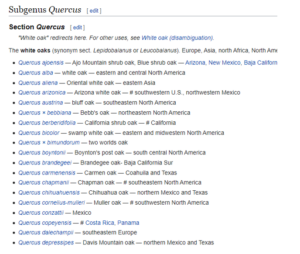
There are exceptions that cross over this section and act as a bridge between the different sections.
Quercus. x turneri ‘pseudoturneri’ (Q. robur x Q. ilex) white oak x cerise section
(Quercus x macrocarpa x ilex sp. Ballota) white oak x cerise oak sect.
Quercus ×kewensis (Q. cerris x Q. wislizeni) Cerreiche x red oak sect.
There are more than 500 oak species worldwide, and it will be interesting to see the potential of this species.
Article on hybrid oaks from the “international oak seciety”.
“Hybridization in Quercus (as Seen through the Eyes of an Enthusiast).”
By Jeroen Braakman | February 17, 2017
quoat:
“What makes this fascinating is that when oaks are planted together in a city park or, even better, an arboretum, very interesting things can happen! Even when two oaks don’t share habitat in the wild, they are able to hybridize. A well-known example is Q. Pondaim Group, a group of hybrids resulting from the cross between the East Asian Q. dentata and the Caucasian Q. pontica. Another example, which as far as I know is the only known case of intersectional hybridization, is Q. ×kewensis, where two oaks of different sections seem to have found each other: Q. cerris (Cerris Section) and Q. wislizeni (Lobatae or Red Oak Section). A third example, well known in the tree trade, is Q. ×bimundorum (Q. robur × Q.alba), which has proven hybrids can be valuable as well, because some problems can be solved. In this case, the hybrid is resistant to mildew, a notorious problem on Q. robur and other species related to it; also, the autumn color has been improved, as Q. robur usually does not have good autumn color. ”
Oil oak
Sam Thayer when asked which oaks are suitable for oil extraction.
“Patrick,
I have tried many species. The white oak group is very low in oil and generally this cannot be expressed with an expeller. The red oak group in general is higher, but still not very practical. But there is a subset within the red oak group with very small acorns with bright orange flesh, and these kernels are more than 50% oil by volume. These are a distinct group, but not recognized as any subgenus or other taxonomic division. Included are Quercus nigra, Q. phellos, Q. imbricaria, and Q. falcata. But there are some more. All are endemic to the southeastern US. I can’t explain ecologically what is the function of the tiny size and high oil content, but certainly there is a strategy that this form works for.
-Sam”
Oil oaks:
Quercus nigra
Q. phellos
Q. imbricaria
Q. falcata
Q. incana
Here are 2 more interesting hybrids from the section of red oaks:
ShuWater Oak Hybrid (Quercus x neopalmeri) (nigra x shumardii)
https://www.nativnurseries.com/products/shuwater-oak-hybrid-for-salequercus-x-neopalmeri
Water x Nuttall Oak Hybrid (nigra x texana)
Water x Nuttall Oak Hybrid (nigra x texana)
Sweet fruity or low tannin oaks
Q. macrocarpa ‘Ashworth’
Q. macrocarpa ‘Krieder’
Q. macrocarpa ‘Sweet Idaho
“Manna” Oak Acorns (Quercus macrocarpa x Ashworth cross).
“Nutty” Oak Acorns (Quercus x macrocarpa x ilex sp. ballota).
“Sweet It Is” Bebbs Oak (Quercus x bebbiana (macrocarpa x alba))
Holm oak Quercus ilex subsp. Rotundifolia
Quercus rotundifolia x robur
And many without variety names see nurseries
Nurseries with sweet acorns on offer:
www.Oikostreecrops.com USA
https://morsenursery.com/USA
https://www.nativnurseries.com/ USA
http://balanotrees.org/ Spain
https://quercusreal.com/Spain
Hortensis.com
Lubera.ch
https://www.houzz.com/discussions/6103909/farewell-to-another-mail-order-enthusiast-s-nursery-oikos
Literature:
Balano Cult: Rediscover the acorn – an ancient staple, for the sustainable development of our food culture.
from Peter Becker
Manual de Cocina Bellotera para la Era Post Petrolera Una propuesta artística y revolusionaria para encarar el cenit de los seres nada
Tree Crops a permanent agriculture
By J.russell smith
The book is available as public domain at https://libgen.li/.
Cornucopia 2 A Sorce BOOk of Eddible Plant
By Stephen Facciola
Restoration Agriculture: Real World Permaculture for Farmers
By: Mark Shepart
Eating Acorns: Field Guide-Cookbook-Inspiration
By: Marcie Lee Mayer
As Sweet As it Gets
By Joan Montserrat www.balanotrees.org info@balanotrees.org
Clonal Oak Propagation by Grafting
from Dirk Benoit Pavia Nurseries
“Preliminary Investigations into the Potential of Oak Acorns for Commercial Production: Korean.
Precedent, Mast Behavior, and Directions for Future Breeding as an Animal Feed Crop.”
Fermenting wild plants
by Michael Machatschek
Luther Burbank (Volume 11) his methods and discoveries and their practical application
The book is available as public domain on ebooksread.com.
New findings from plant sciences
By Dr. Manuela Dahinden
Growing Hybrid Hazelnuts The New Resilient Crop for a Changing Climate
http://www.badgersett.com/
By Brandon Rutter-Daywater,Philip Rutter and Susan Wiegrefe
Images oil oaks
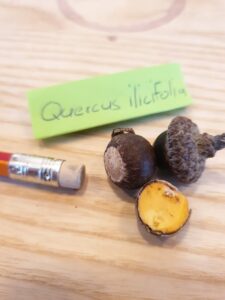
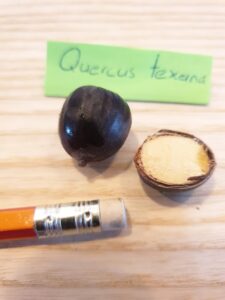
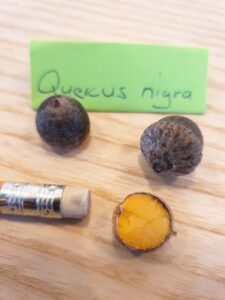
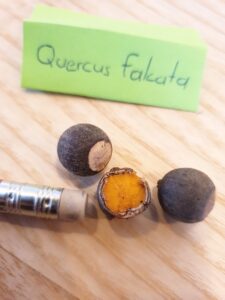
unlike Q.robur, the inside of the acorns is very soft it is easy to crush.
In the following photos you can see a paper on which the acorns were crushed after drying in the oven at 120C. in Q.nigra the “fat spot” is most pronounced.
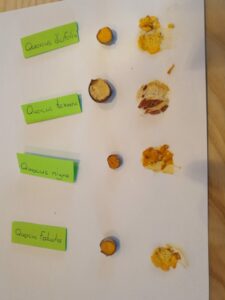
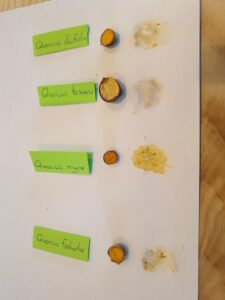
visite me on youtube
